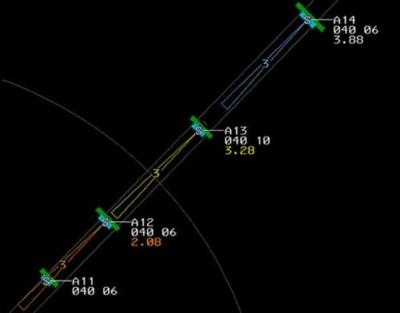Fri, Sep 09, 2011
First Use At Minneapolis-St. Paul Leads Way For NextGen Support
Nationally
Air traffic controllers at the Minneapolis Terminal Radar
Approach Control (TRACON) are using an innovative next generation
tool developed by The FAA and Lockheed Martin to help maintain safe
separation between aircraft on final approach. The advancement
enhances the Common Automated Radar Terminal System (CARTS), a
program Lockheed Martin primes for the FAA at more than 100 TRACONs
nationally.

Known as Automated Terminal Proximity Alert (ATPA), the tool
automatically lets controllers at the Minneapolis-St. Paul
International Airport know what the distance is between aircraft
that are flying in-line instrument approaches. Another feature is
that the system will visually alert a controller when a trailing
plane is predicted to get too close to an aircraft ahead of it,
allowing the controller to take action before a loss of standard
separation occurs. The tool is an example of how the FAA is
applying applications today that are tied to its next generation
air transportation strategy.
"ATPA is a tool that will help controllers optimize performance
using existing separation standards," said Sandra Samuel, vice
president of Lockheed Martin's IS&GS-Civil Transportation
Solutions business. "Being able to roll out ATPA now demonstrates
Lockheed Martin's commitment to providing the FAA with NextGen
improvements today, not tomorrow."
One useful feature of ATPA is the distance processing. The
controller's radar display will show the distance between two
aircraft on final approach, placing the amount of separation next
to the track of the trailing flight.

Another feature controllers at the Minneapolis TRACON are
finding helpful is the ATPA's warning and alert cones. The cones
show up on a controller's radar display when the trailing plane is
predicted to get too close to the aircraft ahead of it. The narrow
end of the cone starts at the trailing plane, with the broader end
extending toward the leading aircraft. The colors of the cones are
changed when the aircraft are projected to get closer than the
minimum required separation, prompting the controller to take
action.
"Controllers had a previous tool that required them to enable
graphics manually, but their desire for automation led to the
development of ATPA," Samuel said. "This new capability will
support increased arrival rates by helping controllers consistently
maintain the precise minimum aircraft separation standards."
The St. Louis TRACON is also using the tool, and it should be
available at the Chicago and Denver TRACONs soon. Current plans are
to bring ATPA to other CARTS facilities that have color displays by
the end of the year.
More News
Have A Story That NEEDS To Be Featured On Aero-News? Here’s How To Submit A Story To Our Team Some of the greatest new stories ANN has ever covered have been submitted by our>[...]
“The legislation now includes a task force with industry representation ensuring that we have a seat at the table and our voice will be heard as conversations about the futur>[...]
Aero Linx: Waco Museum The WACO Historical Society, in addition to preserving aviation's past, is also dedicated and actively works to nurture aviation's future through its Learnin>[...]
Adcock Range National low-frequency radio navigation system (c.1930-c.1950) replaced by an omnirange (VOR) system. It consisted of four segmented quadrants broadcasting Morse Code >[...]
Also: uAvionix AV-Link, Does Simming Make Better Pilots?, World Games, AMA National Fun Fly Czech sportplane manufacturer Direct Fly has finished delivering its 200th ALTO NG, the >[...]
 ANN FAQ: Submit a News Story!
ANN FAQ: Submit a News Story! Aero-News: Quote of the Day (06.12.24)
Aero-News: Quote of the Day (06.12.24) ANN's Daily Aero-Linx (06.12.24)
ANN's Daily Aero-Linx (06.12.24) ANN's Daily Aero-Term (06.12.24): Adcock Range
ANN's Daily Aero-Term (06.12.24): Adcock Range Airborne Affordable Flyers 06.06.24: 200th ALTO, Rotax SB, Risen 916iSV
Airborne Affordable Flyers 06.06.24: 200th ALTO, Rotax SB, Risen 916iSV




